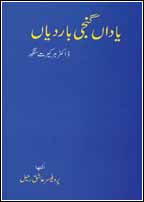Reviewed by Shafqat Tanvir Mirza
by: Shafqat Tanwir Mirza
The Dawn: June 1, 2008
 Prof Dr Harkirat Singh was for long haunted by the feeling that justice had not been done to the people of East and West Punjab who lost so much at the time of partition in 1947. Eventually, the editor of Daily Tribune (Punjabi) prevailed upon him to write the story of his own ‘paradise’ in the upper semi desert areas of Multan known as Ganji Bar, one of the bar (wastelands) along with Sandal, Neeli and Keerana.
Prof Dr Harkirat Singh was for long haunted by the feeling that justice had not been done to the people of East and West Punjab who lost so much at the time of partition in 1947. Eventually, the editor of Daily Tribune (Punjabi) prevailed upon him to write the story of his own ‘paradise’ in the upper semi desert areas of Multan known as Ganji Bar, one of the bar (wastelands) along with Sandal, Neeli and Keerana.
The area is located between rivers Ravi and Chenab on one side and Sutlej on the other and was colonised between 1914 and 1923. The water drawn from the Jhelum and Chenab irrigated this northern part of the then district of Multan and here were settled Sikh veterans of the First World War and their earlier comrades mainly from the Jullunder and Ambala divisions where they had very small landholdings.
Dr Harkirat’s family migrated from Gurdaspur to the far off Chak No. 79 between Khanewal and Tulamb — a historical place where Alexander met with tough resistance and Taimur’s forces carried out a massacre. Five to six miles from Tulamba in the east is the place where Ram, Laxman and Seeta came to live when they were exiled. The area was known as Sidhnai or Sidh. Here the Ravi flows in a straight line for almost ten miles, creating many legends in its path.
The area where the Sikhs were assigned to break virgin land was desert and semi-desert with shrubs and the rich trees of vann whose fruit, peeloo, had inspired Khawaja Farid to write some of his famous lines. The land was also replete with mirages. The local population consisted mainly of nomad Rajput tribes who survived on a pastoral economy. They were all Muslim and remained semi-independent with no permanent settlements of their own.
Harkirat Singh’s story begins in the Gheeney dey Bangar village in Batala tehsil in 1920 when his havaldar uncle — a first cousin of his father’s — was allotted a square of land in Ganji Bar. Harkirat was at the time in Jabalpur with his father who was also in the army. From what he later heard from his uncles, the caravan that set out for Ganji Bar consisted of his grandfather, grandmother and granduncles, a couple of uncles and a servant named Santa. Apart from the bullock in front of their cart, some cows and buffaloes, one dog and two horses completed the entourage.
The 225-mile-long journey was covered in about 25 days with no familiar face to welcome them in their new home. A Muslim jungli, the name given to the local inhabitants of the bar (jungle), stepped up to fill the place. He extended all possible help to the newly arrivals. The family had to live in the open for about 20 days until they made a hut for themselves. Over the next many years Harkirat’s grandmother, Eido, played hostess to everyone who landed in this place where hyenas and wolves roamed around.
Paradise was complete and in full bloom when partition came. The Sikh inhabitants of the four chaks (settlements) founded by Sikh ex-army men had no option but to leave.
The place was waiting to be transformed. Within three or four years the ex-army men raised their houses, a gurudwara, marrhi (the burial place), shops, workshops and were harvesting crops the size they could not have dreamed of earlier. The author calls it life in paradise. In time a school came up and the villages were now so prosperous that they frequently attracted the rahs dharis and mundalis, theatre often associated with religion.
According to Prof Harkirat Singh of Patiala University, the paradise was complete and in full bloom when the partition came. The Sikh inhabitants of the four chaks (settlements) founded by Sikh ex-army men had no option but to leave. They distributed their household articles among the Muslim and Christian co-villagers, which were accepted with a heavy heart. The animals were unfastened. Mai Eido, now above 90, had to lock her house as she had done in Gheeney dey Bangar in 1920-21.
It was September, 4, 1947 when Mai Eido was helped onto the bullock cart which was to head to Fazilka via Khanewal, Vehari and Sulemanki. The return journey for the grandmother of Chak 79 had begun. Soon afterwards she breathed her last and amid the chaos that accompanied the Partition, all her family could do was entrust her body to the water in the Vehari canal.
Curtains were drawn on the self-made paradise. But no one could wipe it clean of Prof Harkirat Singh’s memory.